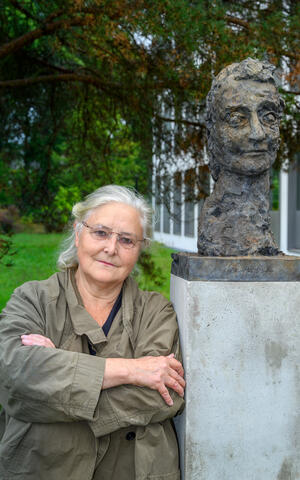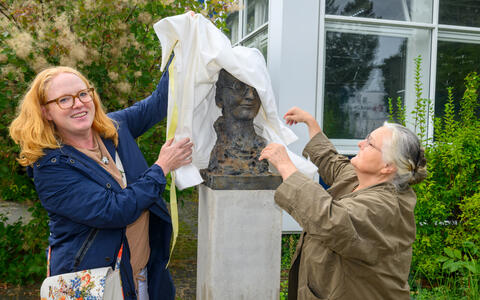Sculptures of Marthe and Marguerite Vogt unveiled
Sisters Marthe and Marguerite Vogt were extraordinary women scientists who had a remarkable degree of success in their chosen fields. Their work greatly influenced other researchers and provided valuable insights into the neurosciences and cancer research. Yet the Vogts were often overlooked when it came to distinctions and awards. On September 8, 2022 – what would have been Marthe’s 119th birthday – portrait busts of the two great scientists were unveiled at the Berlin-Buch campus. The artworks can be seen in front of the two buildings that now bear the sisters’ names.
Sculptor Anna Franziska Schwarzbach next to the bust of Marthe Vogt she created.
Marthe Vogt
Marthe Louise Vogt was born in Berlin in 1903, the eldest daughter of celebrated scientists Oskar Vogt and Cécile Vogt-Mugnier. Marthe studied medicine and chemistry in Berlin, ultimately obtaining a doctorate. In 1935 she left Germany for the United Kingdom. She worked in Cambridge and London with such renowned scientists as Nobel Prize winner Henry Hallett Dale. Together, she and Dale were the first to identify adrenaline as a possible neurotransmitter in the central nervous system. Even after retiring in 1966, Vogt continued with her research. In 1990 she moved to California to live with her sister Marguerite. She died in 2003, the day after her 100th birthday.
Marthe Vogt is remembered as a great pharmacologist and neuroscientist whose work formed the basis of modern neuropharmacology. Without her insights, we would not be able to explain the effects of many psychoactive drugs and muscle relaxants.
Marguerite Vogt
Marguerite Vogt, the younger sister of Marthe Vogt, was born in 1913. She studied medicine in Berlin, obtaining her doctorate in 1937. In 1950 she left Germany for the United States, where she focused on virology. In California, she worked with Renato Dulbecco, who would later go on to win a Nobel Prize. Together, Vogt and Dulbecco were the first to successfully culture the polio virus, which enabled the subsequent development of a polio vaccine. In the following years, Vogt directed her attention to cancer-causing viruses, generating invaluable insights into tumor development. She died in California in 2007.
Marguerite Vogt is considered one of the most outstanding women scientists of the 20th century, yet she never received a major prize. She had no interest in public appearances or in making a name for herself; she preferred to stay in the background, pursuing her research interests in the lab. However, her technical abilities as a cell culturist and her commitment to the promotion of young scientists made her a sought-after mentor, and many of her charges went on to become Nobel laureates. Now, the Berlin-Buch campus is honoring this great woman scientist in two ways. As well as prominently displaying her portrait bust, it has named the building that houses the science library the “Marguerite-Vogt-Haus.”
The kick-off for CAMPUSart
The two portrait busts were sculpted by award-winning artist Anna Franziska Schwarzbach, whose work can be found at several locations around the Berlin-Buch campus. They include the memorial to the victims of the National Socialist “euthanasia” murders as well as busts of Nobel Prize winner Marie Curie and the Max Delbrück Center’s founding director Detlev Ganten.
The new sculptures continue the tradition of naming buildings at the Berlin-Buch campus after renowned scientists and adorning their entrances with portrait busts of the respective individuals. The unveiling of the two busts and the renaming of the library marked the launch of the new CAMPUSart project, which aims to make the artworks, botanical curiosities, and science history collections at the Berlin-Buch campus accessible to the public. The project will have a comprehensive website and include tours, audio guides, and a selection of pertinent publications.
The new sculptures are part of the “Kunst und Wissenschaft im Park” project financed by LOTTO-Stiftung Berlin, the Max Delbrück Center’s own resources, and various institutions at the Berlin-Buch campus.
Text: Campus Berlin-Buch









